
views
Using In-Text Citations

Find the page number of your source. Use the exact page that the fact or quote appeared on. If it appeared on more than 1 page, record the entire page range. You can usually find page numbers on the top or bottom corner of a page. For example, if you found a quote on page 10 of a book, cite page 10. If the information was spread over several pages, include all of them. So you might cite pages 10-16. Sometimes, page numbers might have letters like "B1" or use Roman numerals like "iv" or "xi." In these cases, always use the type of numbering used by the source.
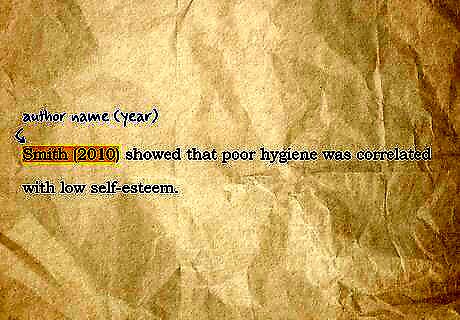
Write out your sentence. You do not need to include the page numbers in the text of the sentence itself. This sentence should include the information on the pages that you found. If you name the author in the sentence, write the year that the source was published in parentheses next to the author’s name. For example, you might write, “Smith (2010) showed that poor hygiene was correlated with low self-esteem.”
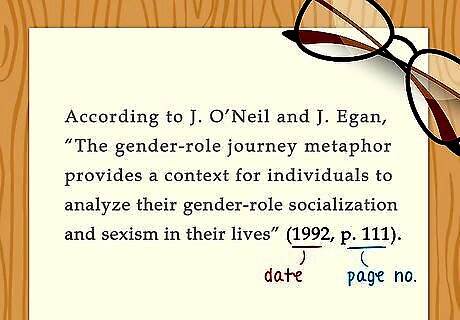
Write the page number in parentheses at the end of the sentence. Put the parentheses before the period. How you format the citation depends on whether or not you named the author in the sentence. If you named the author in the sentence, just put the page number at the end of the sentence. For example, “Smith (2010) showed that poor hygiene was correlated with low self-esteem (p. 40).” If you did not name the author within the text of the sentence, include the author’s last name and the year of publication before the page number in the parentheses. For example, “One study showed that poor hygiene was correlated with low self-esteem (Smith, 2010, p. 40).”
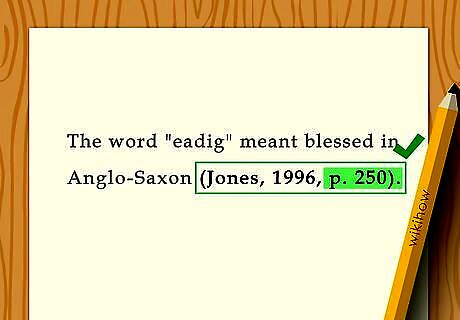
Write p or pp before the page number. If you are only citing information from a single page, you just need to put the "p." before the page number. If there are multiple consecutive pages, write "pp." before the number instead of "p." Separate the page numbers with a hyphen. A single page number citation might look like (Smith, 2010, p. 40) or (p. 40). A citation for multiple, sequential pages might look like (Smith, 2010, pp. 40-45) or (pp. 40-45).
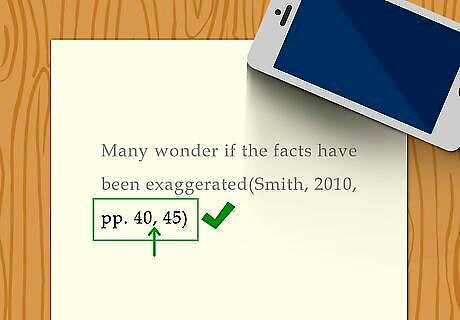
Put commas between non-sequential page numbers. If the information you need is on 2 or more non-consecutive pages, you should still cite all of the relevant pages. Use "pp." before the page numbers. For example, if the information started on page 40 but then continued on page 45, you would write (Smith, 2010, pp. 40, 45).
Writing a Reference List

Find the full page range of the book chapter or article. Don’t just cite the few pages that you used. Look for the first and last page number of the article. This is the page range. So if a chapter begins on page 27 and ends on page 45, your page range is 27- 45. Newspaper articles may have page numbers that include letters (such as 1A or B3) while prefaces may use roman numerals (like i, ii, iii, etc.). Always use the numbering system used by the source. If the article skips pages, write down where the pages begin and end in both sections. Put a comma between these page numbers. For example, 15-20, 25-30. Make sure to include reference lists, appendixes, and other supplementary material in your page range. So if the text of the article ends on page 173 but the appendix ends on page 180, then the page range ends on page 180.

Write out the full reference of the text. The format of the citation depends on the type of source you use. Since page numbers are generally only used for book chapters and articles, you can use the following guidelines to help you cite. Book chapter: Last name, First Initial. Second Initial (if applicable). (Year of publication). Title of chapter. In A. Editor & B. Editor (Eds.), Title of book (pages of chapter). Location: Publisher. Article: Author, A. & Author, B. (Year). Title of article. Title of periodical, volume number (issue number), pages of article.

Insert the page range between the title and location for a book chapter. Put the page numbers in parentheses, and separate them with a hyphen. Write “pp.” before the number. For example, if you were citing a chapter between pages 41 and 63, your citation might look like this: Williams, B. and Johnson, A. (1990). Traffic Patterns and Urban Spread. in C. Carr (Ed.), Traffic Engineering Trends (pp. 41-63). New York: ZMN Publishing.
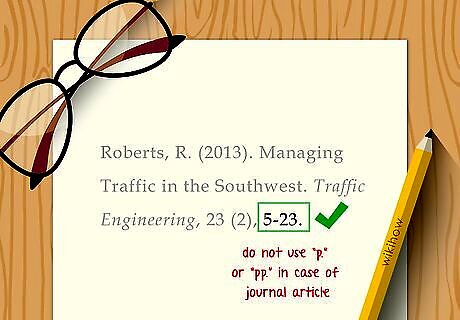
Include the page range at the end for a journal article. Do not use “p.” or “pp.” before the page number. Just separate the first and last page with a hyphen. So if you cited a journal article that appeared on pages 5-23, it might look like this: Roberts, R. (2013). Managing Traffic in the Southwest. Traffic Engineering, 23 (2), 5-23.
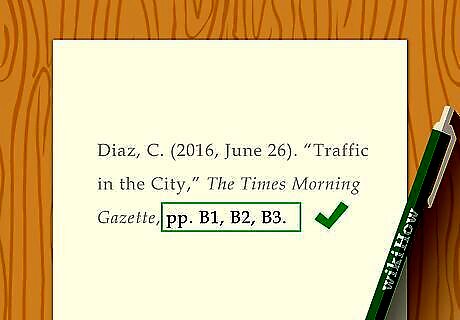
List out each page for a newspaper article. Page numbers from a newspaper are cited slightly differently than other types of articles, such as journal or magazine articles. Before the page numbers, write “p.” for a single page and “pp.” for multiple pages. List out the pages individually if they are non-consecutive. For example, you might cite an article that starts on page B1 and continues through pages B3 and B4 as: Diaz, C. (2016, June 26). “Traffic in the City,” The Times Morning Gazette, pp. B1, B3-B4.
Knowing When to Use Page Numbers
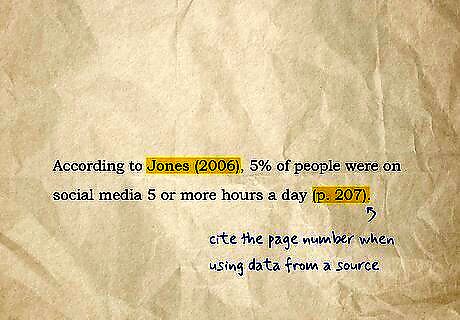
Cite the page number when using statistics or data from a source. If you have included data, statistics, or other numbers from a scientific study, you should indicate which page of the study this information appeared in. For example, you might write, “According to Jones (2006), 5% of people were on social media 5 or more hours a day (p. 207).”
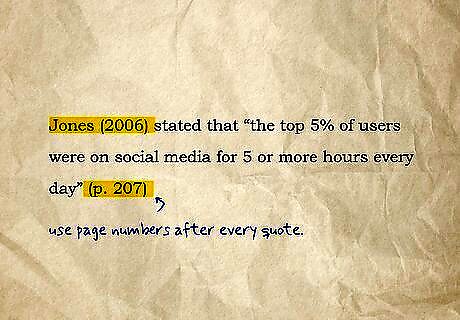
Put page numbers after every quote. Write the page numbers after the quotation marks but before the period. You should do this with quotes from all books, articles, and chapters. For example, you might write: Jones (2006) stated that “the top 5% of users were on social media for 5 or more hours every day” (p. 207).

Consider including a page number if paraphrasing. Paraphrasing means that you are restating the author’s general ideas, arguments, or results in your own words. You do not need page numbers in this case, but they will be helpful if you are paraphrasing a specific section from a very long or complicated work. For example, you might say: “Jones (2006) indicated that addictive behaviors could be seen in a small population of excessive users (p. 207).”

Write the paragraph number if there are no page numbers. If you are quoting or citing a website or a source without page numbers, you should use paragraph numbers instead. You generally only need to do this when citing specific data and quotes. You do not need to put the paragraph number in the reference list. You can cite a paragraph the same way as a page number, except you write “para.” instead of “p.” So if you were quoting paragraph 3, it would look like (para. 3) or even (James, 2007, para. 3). To find the paragraph number, count from the top paragraph down to the paragraph you are citing. So a quote from the third paragraph would be cited as paragraph 3.














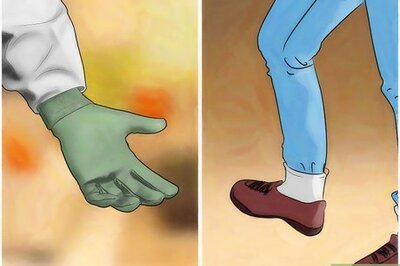





Comments
0 comment